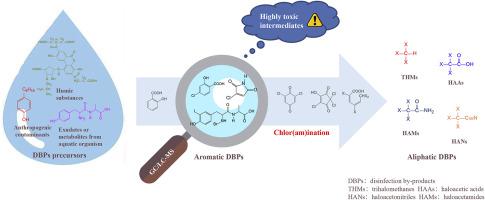Water Research ( IF 12.8 ) Pub Date : 2020-07-01 , DOI: 10.1016/j.watres.2020.116076 Xiaoyu Liu 1 , Li Chen 1 , Mengting Yang 2 , Chaoqun Tan 3 , Wenhai Chu 1

|
With the development of analytical technology, more emerging disinfection by-products (DBPs) have been identified and detected. Among them, aromatic DBPs, especially heterocyclic DBPs, possess relatively high toxicity compared with regulated DBPs, which has been proved by bioassays. Thus, the occurrence of aromatic DBPs is of great concern. This article provides a comprehensive review and summary of the characteristics, occurrence, transformation pathways and control of aromatic DBPs. Aromatic DBPs are frequently detected in drinking water, wastewater and swimming pool water, among which swimming pool water illustrates highest concentration. Considering the relatively high concentration and toxicity, halophenylacetonitriles (HPANs) and halonitrophenols (HNPs) are more likely to be toxicity driver among frequently detected phenyl DBPs. Aromatic DBPs can be viewed as important intermediate products of dissolved organic matter (DOM) during chlor(am)ination. High molecular weight DOM could convert to aromatic DBPs via direct or indirect pathways, and they can further decompose into regulated aliphatic DBPs such as trihalomethanes (THMs) and haloacetic acids (HAAs) by ring opening and side chain cleavage. Even though no single DBPs control strategy is efficient to all aromatic DBPs, the decrease of overall toxicity may be achieved by several methods including absorption, solar radiation and boiling. By systematically considering aromatic DBPs and aliphatic DBPs, a better trade-off can be made to reduce health risk induced by DBPs.
中文翻译:

芳香消毒副产物的产生,特征,转化和控制:综述。
随着分析技术的发展,越来越多的新兴消毒副产物(DBP)被发现和发现。其中,芳烃DBPs,尤其是杂环DBPs,与受管制的DBPs相比,具有较高的毒性,这已通过生物测定证明。因此,芳族DBP的出现是非常令人关注的。本文对芳香族DBP的特性,发生,转化途径和控制进行了全面的综述和总结。经常在饮用水,废水和游泳池水中检测到芳香DBP,其中游泳池水浓度最高。考虑到相对较高的浓度和毒性,在经常检测到的苯基DBP中,卤代苯基乙腈(HPAN)和卤代硝基酚(HNP)更可能是毒性驱动因素。芳族DBP可以看作是氯(氨)化过程中溶解有机物(DOM)的重要中间产物。高分子量DOM可以通过直接或间接途径转化为芳族DBP,并且它们可以通过开环和侧链断裂进一步分解为受调节的脂肪族DBP,例如三卤甲烷(THM)和卤乙酸(HAA)。即使没有单一的DBP控制策略对所有芳香族DBP都是有效的,但可以通过多种方法(包括吸收,太阳辐射和煮沸)来降低总体毒性。通过系统地考虑芳族DBP和脂族DBP,可以做出更好的权衡以降低DBP引起的健康风险。高分子量DOM可以通过直接或间接途径转化为芳族DBP,并且它们可以通过开环和侧链断裂进一步分解为受调节的脂肪族DBP,例如三卤甲烷(THM)和卤乙酸(HAA)。即使没有单一的DBP控制策略对所有芳香族DBP都是有效的,但可以通过多种方法(包括吸收,太阳辐射和煮沸)来降低总体毒性。通过系统地考虑芳族DBP和脂族DBP,可以做出更好的权衡以降低DBP引起的健康风险。高分子量DOM可以通过直接或间接途径转化为芳族DBP,并且它们可以通过开环和侧链断裂进一步分解为受调节的脂肪族DBP,例如三卤甲烷(THM)和卤乙酸(HAA)。即使没有单一的DBP控制策略对所有芳香族DBP都是有效的,但可以通过多种方法(包括吸收,太阳辐射和煮沸)来降低总体毒性。通过系统地考虑芳族DBP和脂族DBP,可以做出更好的权衡以降低DBP引起的健康风险。即使没有单一的DBP控制策略对所有芳香族DBP都是有效的,但可以通过多种方法(包括吸收,太阳辐射和煮沸)来降低总体毒性。通过系统地考虑芳族DBP和脂族DBP,可以做出更好的权衡以降低DBP引起的健康风险。即使没有单一的DBP控制策略对所有芳香族DBP都是有效的,但可以通过多种方法(包括吸收,太阳辐射和煮沸)来降低总体毒性。通过系统地考虑芳族DBP和脂族DBP,可以做出更好的权衡以降低DBP引起的健康风险。



























 京公网安备 11010802027423号
京公网安备 11010802027423号